Judging by the currently charting single, “Hollow Moon (Bad Wolf)," which was born out of a 4 a.m. moment when a jet-lagged Bruno got inspired watching the sunrise—he should probably get out of bed whenever the music calls to him. Bruno says that song is among his favorites on Run, his band's sophomore album. Band is a relative term here, though, because Bruno wrote, performed, and recorded everything on the album with only his engineer, Eric Stenman, by his side.
AWOL's 2011 debut, Megalithic Symphony, came about much the same way, with Bruno tracking about 70 percent of the sounds. He wasn't prepared for the level of success reached by “Sail," his first hit. “I never expect anything to top the absolute phenomenon and freak of nature that 'Sail' became," Bruno says. “It's a weird miracle. If anything, it's great to have that as an advertisement for people to check out what I'm all about."
who has heard it."
After years of trudging the trenches in punk and hardcore bands—Home Town Hero and Under the Influence of Giants among them—“Sail" has given Bruno the freedom to make his Megalithic follow-up the way he wanted. Run is a sophisticated collection of 14 songs that swim in contrasts, from Bruno's catchy melodies and pristine falsetto to his savage low-end lines punctuated by a fearless growl and thought-provoking lyrics. Though Bruno is the studio mastermind, AWOL tours as a traditional rock group with Bruno at the helm, Drew Stewart and Kenny Carkeet on guitars, and Isaac Carpenter on drums.
Citing influences as wide-ranging as Radiohead (“OK Computer is an example of a psychedelic art record that I'm still blown away by"), NWA, and The Shape of Punk to Come by Refused, Bruno says rhythm and groove are what he's about.
The core-shaking low-end on several of Run's tracks is an undeniable force, yet there was no actual bass guitar used on the album. Those parts are actually guitars, and sometimes it's hard to decipher what's happening. “It's a non-traditional use of guitars," says engineer Stenman, “but there are a ton of them and they play a huge role on the record."
Though Bruno has been playing guitar since he was in the single digits, bonding with his father over a nylon string and “La Bamba," he maintains he's a “basic level" player. Yet all of his songs start with a guitar and an idea. It's where they end up that's a little more complicated.
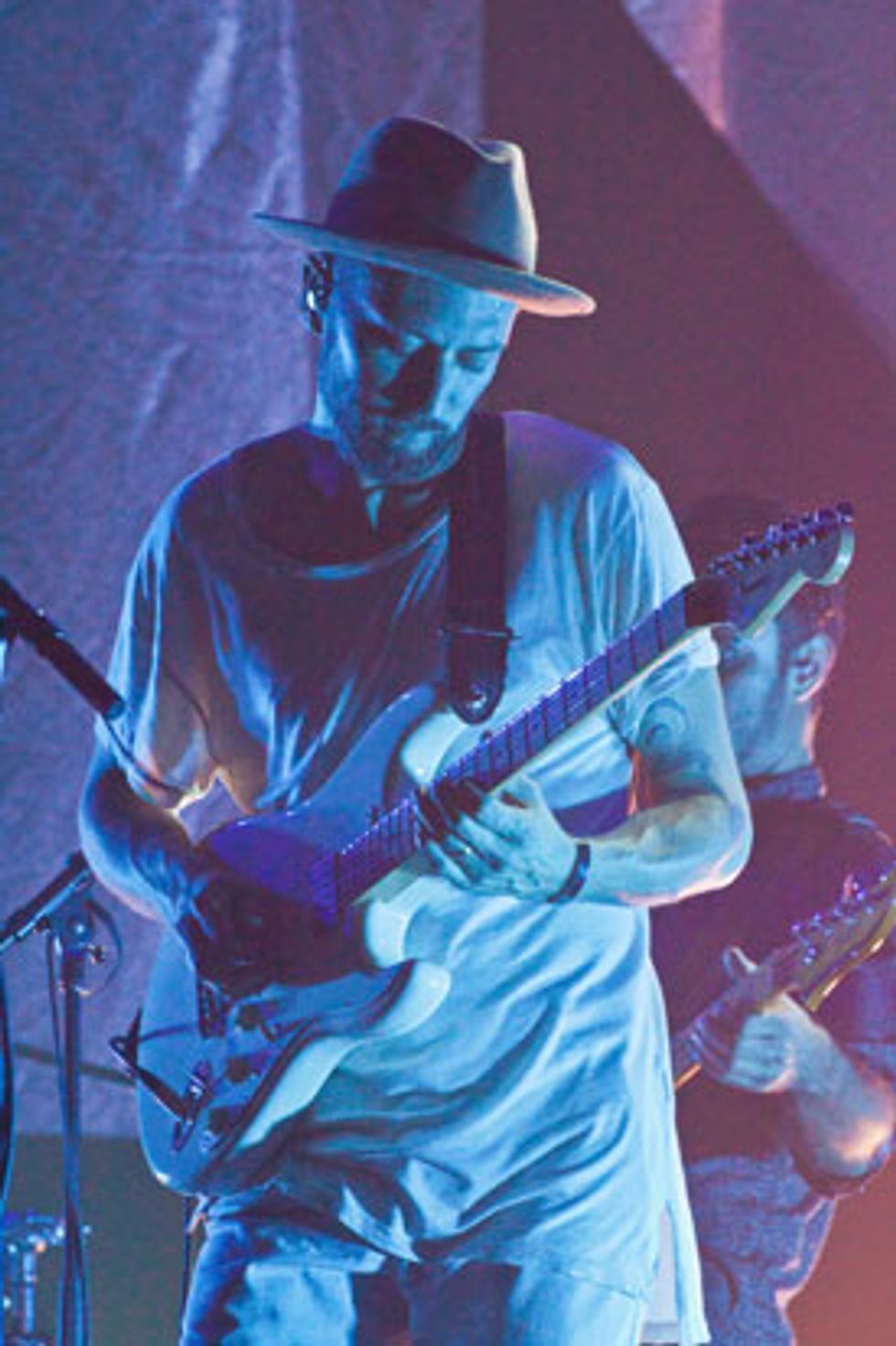
The live AWOLNATION experience is different from the recorded album. Onstage, Bruno mostly focuses on vocals and leaves the guitar to his hired guns, Drew Stewart (shown here with his dual-humbucker Fender American Standard Strat at SXSW 2015) and Kenny Carkeet. Photo by Chris Kies.
Can you recall any musical epiphany or “a-ha moment" where you realized this is what you're supposed to be doing?
The first epic moment would've been jamming with my dad, and him showing me a basic chord progression and getting me to stretch my fingers. That was not only huge musically for me, but also a huge bonding moment with pops.
It wasn't until high school that I decided to record my voice. Once I started writing and recording songs on an old-school 4-track Tascam recorder, I knew it was the best escape for me. It was constructive, creative, and therapeutic. It was really just an exercise to get away from everything else that was going on in my life and a way to figure out who I was.
When I added harmonies for the first time, I thought, “That sounds like a real record that a professional would do." I just felt awesome, secretly in my own bedroom. Still to this day, my favorite part of this whole process is the discovery period of a song because you're the only one who has heard it. That's really exciting. Then you throw it out there and it becomes everyone else's, but for the longest time it's my own little secret and that means the world to me.
What kind of guitarist are you?
I don't have one answer for that question. When it comes down to melody and lyrics, more times than not I go back to my guitar because that's what I feel most comfortable playing. I have a better understanding of it than any other instrument, besides drums. I don't do a lot of writing when I'm sitting on a drum kit, although I have, but not as frequently as a guitar.
Are you serious or laid-back in the studio?
It's very serious when I have an idea that's exciting to me because I'm motivated and it seems urgent and powerful. I become paranoid that I'm going to lose the idea if I don't let it flow through me as soon as possible. But I'm pretty mellow about the whole thing. I'm not a 9-to-5 studio guy. At a certain point my ears can't handle anymore and I don't even know what I'm listening to. That's when my judgment is skewed, so I never overdo it. I find that having a fresh, clear perspective is one of the key ingredients for doing the best work I'm capable of.
You wrote, performed, and produced everything on the new album. Does this come naturally for you?
There's no one to argue with—there's only one cook in the kitchen and that's great ... but it's also pretty terrifying to be alone. You have this body of work, and then at the end of the night you look in the mirror and go, “Is this really good or am I totally full of shit and I can't see it myself?"
There are darker, heavier moments doing it the way I did on this record because of that constant pressure that I put on myself. I think the end result was different and better than I could've done any other way because I was so critical. Other producers, they're going to move on to the next project, but for me, this is everything.
Do you keep musical notes while you're just walking around, living your life, and ideas hit you?
Exactly. It could be anything. It could be the rhythm of the left turn signal in my car combined with another sound I made when my wrist hit the side of the door. Maybe that sounds like a snare drum to me, and then all of a sudden I have this groove that I want to get to. I try my best to at least record voice memos on my phone, like I'm sure every other artist in the world does.
I get anxiety when I don't work on something. I have hundreds, maybe thousands of unfinished ideas that have something I think could be great about them.
“I want people to walk away thinking, 'Wow, I don't even know what just happened to my brain.'"
Photo by Dave Lichterman.
Let's talk about the first single, “Hollow Moon (Bad Wolf)." What's the inspiration behind it?
We'd just gotten back from a great European tour. I was jet-lagged and I woke up at 4 a.m. with this weird, hazy, hungover vibe. I watched the sun coming up and wrote this way mellower, ambient version of the song. I didn't even know if it was going to be on the record, it just seemed interesting. I could see the moon at the same time, so that's what I labeled the session—“Hollow Moon." It's something I'd been interested in on a sci-fi level. I took it to the studio with Eric my engineer, where we put the energy into the song, which wasn't intentional.
All right, it's 4 a.m. and you're jet-lagged and looking at the moon. What do you use to record the idea?
I have my own Pro Tools rig at home on my laptop, and that's where I usually start demo ideas. Most of my demos end up being extremely lo-fi sounding, more than the recorded version … but you can't beat that demo you have as an artist.
You've got a mean low-end fuzz going on in a lot of tracks on the album, like at the end of “KOOKSEVERYWHERE." Is that a bass?
I can tell you that I never played any bass guitar on this record. I never—not once—held a bass in my hand. It wasn't intentional, but it's really cool to me and I'm proud of it now. Having said that, there are definitely ways to get bass guitar sounds out of other instruments. That could be a guitar with an octave pedal or a Moog-style synth where you can get that low-end power.
That power of low end is so important to me, it's kind of the heart and soul of the record in a lot of ways. So I don't necessarily have a formula or any rules of how I get it to sound on those specific parts I think you're referring to. I just want it to sound as massive and as brutal as the heaviest metal records, and at the same time as gigantic as any of my favorite hip-hop albums, but—hopefully—with the integrity and credibility of the best-sounding guitar tones that I loved growing up so much.
Did you use a guitar to get those tones?
Yes, of course. But never just one guitar tone. It was a combination of multiple things, so what may sound like just a guitar and some awesome pedal settings is never just that. If we're talking about the low-end breakdown riffs on the record, it's a combination of multiple things to get that power, and guitar is one of those things, but not ever the only thing.
You'd be surprised: Some of the things that clearly seem like a guitar are actually a synth, and some people think I have some sort of synth sound, but it's actually a guitar that sounds like a synth. I have no loyalty to any instruments.
Do you use a pedalboard live?
I do. I just have a tuner pedal and a distortion pedal. That's all I need for the songs I've chosen to play onstage. What we do live is completely different.
Aaron Bruno's Gear
Guitars
Custom powder blue Gibson SG (live)
1981 Gibson Paul (studio)
Gibson ES-335 (studio)
Gibson goldtop Les Paul (studio, belongs to Eric Stenman)
Nash T72 (studio, belongs to Eric Stenman)
Nylon-string acoustic (model unknown)
Amps
Dr. Z MAZ 18 Jr.
Vox AC30
Ampeg SVT-VR head with 8x10 bass cabinet
Fender Deluxe Reverb
Effects
DigiTech Whammy (one vintage model, one current model)
Boss MT-2 Metal Zone
Ibanez TS9 Tube Screamer
Malekko B:ASSMASTER
Boss/Roland RE-20 Space Echo
Strings and Picks
Ernie Ball Beefy Slinky (.011–.054) or Dean Markley Blue Steel (.011–.052)
0.73 mm picks (unknown brand)
Is your live band a democracy?
I haven't run into any huge disagreements with Drew [Stewart] and the guitar parts, and he puts his own twist on it. I don't want it to be the same thing live. I want it to be like the record, but on acid. Pick whichever cool drug you like and that's what I want the music to feel like live. Please understand I'm not trying to encourage anyone to do drugs, I'm just saying metaphorically, I want people to walk away thinking, “Wow, I don't even know what just happened to my brain."
You also use acoustic guitar in some special ways. On the last album, your song “Guilty Filthy Soul" has an intro with a really raunchy acoustic riff that sounds like its doubled. What's going on there?
That was actually only one sound. I recorded that on GarageBand with a nylon-string guitar that just happened to be at the house I was staying at. I don't know what the tuning was still to this day, but I remember having that rhythm in my mind. If my memory serves me correctly I ended on E, so it's like that open-string, no-note nonsense is the first thing you hear going into E, which is not the key we're in when we play the song. That guitar—some piece of shit in the corner—was tuned weirdly. I recorded it with the gain all the way up because it already sounded like hell, so I figured I might as well make it even dirtier. Once we got into the studio I just thought it sounded cool and I wasn't going to get a better tone so we kept it. I'm still shocked to this day that it worked out.
Is that hard to recreate live?
Yeah, it's never going to sound as specifically weird and cool as the record.
Do you have go-to guitars or do you use whatever is available?
I've always enjoyed SGs. When I was a kid I saw a white SG with a black pickup and it looked like a storm trooper to me and I thought that was really cool [laughs]. My cousin was a Gibson rep for a while and he brought an SG over to our house that he let us borrow for three months and I would play it every day. The storm trooper combined with him bringing one over—that was it. I've mostly always played Gibsons. I guess that's just what I know and what's the most comfortable to me.
What guitars did you use in the studio?
I recently got a 1981 Paul, which is the economy version of the Les Paul. There's not a bunch of them out there. It's cool, it's a little bit different. Les Pauls are heavy and hurt my rib cage when I play 'em.
One of the best longboard surfboard shapers in the world is Lance Carson—an iconic pioneer of longboarding and someone I respect very much. He shaped me a board, which I felt honored about and I became buddies with him. In 1982, he gave someone a longboard and the guy couldn't pay him, so he gave Lance this Paul guitar I'm speaking of. I asked Lance if he wanted to sell it and he sold it to me for what I thought was a great price. When I plugged in, it just had this warm feel that I thought was pretty good. That appeared on 80 percent of the guitar moments on Run.
Photo by Matt Arena.
What other main guitars do you use?
I got an ES-335 hollowbody in 2001. It was a gift I got myself when we got signed and had an equipment budget. Five years ago I was so broke that I had to sell it. I sold it to a guy I knew with the understanding that I could buy it back someday. I reached out to him and he was a man of his word. He allowed me to buy it back for the same price.
I custom ordered this powder-blue SG that has a matching powder-blue headstock. That's my baby. I threw it once because I thought I was going to be awesome and smash my guitar earlier on in my career, which is a huge mistake, as everybody knows. I was going through a dark time in my life when I realized the band I was in was going absolutely nowhere, so I tried to destroy my guitar out of rage. It didn't break but it got messed up a little bit. I was able to fix it. It goes out of tune quite a bit, but that's my main guitar. I realized it's pretty much the same guitar that the singer of Spinal Tap plays [laughs]. And at one point my hair was so long that I would crack up every time I played it thinking, “I kinda look like Spinal Tap right now."
What's it like working in the studio with your engineer, Eric Stenman?
There were a couple of moments along the way where Eric was hard to please. I'm like trust me—mute the snare there and move that riff back one bar and see what happens. He's like, “Are you sure?" and I'd say, “Shut the fuck up. I promise you—if I'm wrong I'll give you everything I have."
I have no loyalty to any instruments."
And then we'd be listening back and going “Yes!" We're almost crying with laughter because we're so happy that we did something we'd like as music fans, you know? Those are some of the most fun moments in the studio, and no one's around to see it—it's just me and one guy.
So you like to take musical risks.
Oh, absolutely. The reward is so much greater than playing it safe. The climate of music, especially in our world of alternative music, is really interesting right now. It's become extremely poppy, which is fine, there are some great songs out there. But I feel the world is definitely ready for a little bit of passion, a little bit of anger, and a vulnerable moment for people to relate to. You can only take so many catchy songs without substance. It doesn't really last.
It's all about rhythm to me. What's always moved me are interesting grooves or setting up a groove so that when the one of the bar starts, it hits you like, “Thank god, I didn't know that was coming!" That's what I always love most in music. Those moments that shock my brain. I've studied serious math metal as well, where once a groove locks in after being in all these other chaotic worlds and then comes together, and kind of rolls on the rails for a little moment in time—that's just beauty to me. I'll cry if a riff is that good.
YouTube It
AWOLNATION performs their new single “Hollow Moon (Bad Wolf)" in full-band mode on Jimmy Kimmel Live. Look for one of Bruno's brutal breakdowns near the 3-minute mark.
In a special interview, Rage Against the Machine's bassist Tim Commerford talks with pal Aaron Bruno about the acoustic track “Headrest for My Soul" off of AWOLNATION's new album, Run. Search term: AWOLNATION 'Run' Album Special with Tim Commerford “Headrest for My Soul"
To hear music like yours on the radio is exciting.
The second I heard “Hollow Moon" got added to all these radio stations, I called up Eric [Stenman] and said, “Hey, if the whole world blows up tomorrow, I'll be really proud that we got into millions of people's ears for 24 hours and that we had that brutal of a fucking riff heard on arguably mainstream radio." It still blows my mind that that's happening. So I thought it was a courageous decision by the label to be cool with going with that first. Because there are definitely songs on the record that I think have a more universal appeal, or an anthemic energy to them that would seem to be what most people would assume to go with. But we've been given the creative freedom to set this up like the fantasy records I grew up loving, which is to start with something energetic and exciting to wake people up a little bit.
If your music had an odor, what would yours smell like?
I suppose it would smell like the ocean, which is constantly changing and could be a lot of different things. In the winter it could be heavy or a kind of mist, and in the summer it could have more of a salty vibe because of the heat.
You mentioned that you struggled earlier in your career. What advice would you give to your younger self, or those trying to find their own voice?
You should figure out what you do best and shine on that. The other thing I would have loved to tell my younger self is: You can always write a better song. The minute you throw the towel in on that—it's over.
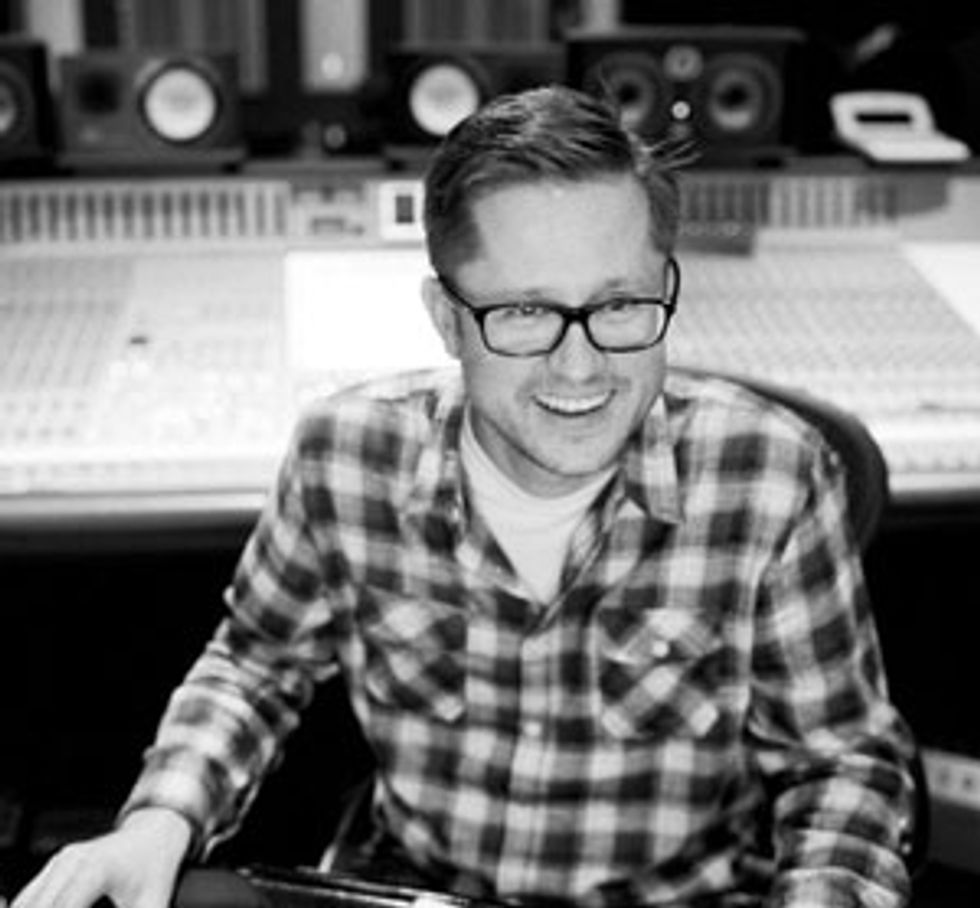
Photo by Jeff Gros.
Eric the Engineer:
Bruno's Right-Hand Man
From field recordings captured on a terminal bus at an airport in Germany to phone messages from friends and wild bass lines too beastly for their own good, AWOLNATION's new album is brimming with wicked sounds. The only other person who worked on realizing those creations with Aaron Bruno was his engineer, Eric Stenman (Lovedrug, Senses Fail, M.I.A, Weezer), who names AWOL as his favorite musical project to work on. He shares his experience with Premier Guitar.
I understand you and Aaron go way back, before working together on Megalithic Symphony?
Yeah, I worked with Aaron way back on his first hardcore straight-edge band back in 1998 or '99 when he was just a kid. We reconnected when he started to make the first AWOLNATION record.
This time around was unique because you were the only other person in the studio for the making of Run.
Aaron is the captain of the ship and I'm the one who's trying to get his ideas through the speakers, just trying to move quickly and keep up with the ideas while they're fresh.
How did this studio experience compare to making the first album?
Every song on the first album he started at home on his simple laptop recording setup and made a skeleton of a song. Then he'd come to me, and we'd build on top of that and replace sounds or add to them. This record started that way and then about halfway through, he started from scratch in the studio. In some ways, he would almost use me as another instrument—it was kind of rapid-fire like, “Okay, give me a hip-hop drum sound … now let's plug in a guitar that sounds like a dreamy, warm guitar tone … now let's do a Rhodes piano." He wrote and played every note on this record, and there was a combination of what he brought in to start with, and then a lot of times inspiration would come from whatever instrument he picked up when he walked into the room.
Let's talk instrumentation. How important were live instruments in the studio?
Aaron writes more on guitar than anything. He has a guitar that his dad gave him, just this old, cheap nylon-string acoustic guitar. He got it redone, set up, cleaned up and back into working order. It made some appearances on the record and was pretty special to him—it was the first instrument he ever owned. It's a piece of crap really, but a cool family heirloom. Any time you hear an acoustic guitar on this record, that's what that was.
What was your approach to getting guitar tones?
Besides that acoustic guitar, there are four guitars on the record. Two of which were Aaron's, two of which were mine. The two guitars I brought into the equation were a Gibson goldtop and a Nash T72, a Telecaster clone. Those were the four electric guitars used over the course of the record.
In the spirit of going quickly and not stopping to over-analyze a guitar tone, there were times when we'd DI a guitar and then maybe reamp it, or just use software or a preamp to blow it up so it sounded nasty.
AWOLNATION isn't your typical guitar-rock band.
I think what AWOLNATION has done in the past, and even more on this record, is to promote an interesting new use of guitars. A lot of it is layered, without a single bass guitar. A lot of what people may traditionally think is a bass guitar on this record was a pitched-down electric guitar with maybe a synth behind it, or the guitars plugged in the DI spot on a preamp and just cranked. And the level into Pro Tools is slammed, and maybe we dropped it down an octave there. So it's a non-traditional use of guitars, but there is a ton of them and they play a huge part on the record.
From the beginning of the title track, to “Hollow Moon (Bad Wolf)," and “KOOKSEVERYWHERE," the low-end guitar tones really standout on the album. How did you get those tones?
Some of that would be as simple as pitching the guitar down in the computer, just playing it with the pitch shifter dropped an octave. Some of it would be my Whammy pedal with an octave drop on it. And then a lot of it would be, whether it's apparent or not, some sort of synth that's going on along with the rhythm of the guitar.
“Run" in particular is one of the Gibson guitars at half speed. Basically, we did the part and it was pitched down to start with, and then also the break section is dropped down—half-time and half-pitch—from there. It was just examining how far we could take a traditionally tuned guitar and then just manipulate the pitch in the recording process.
What type of guitar player is Aaron Bruno?
I would say he's utilitarian. Aaron plays guitar to write songs. He doesn't pick up the guitar as an art form in itself. He's never going to know how to play scales or theory, or how to play an Em7 straight off the bat. Aaron picks up the guitar as part of his toolbox for creating songs. With AWOL it's more than that: There's an aesthetic that comes with the sound and the tonality. He's going to use the guitar to capture a part of a song that's roaming around in his head.


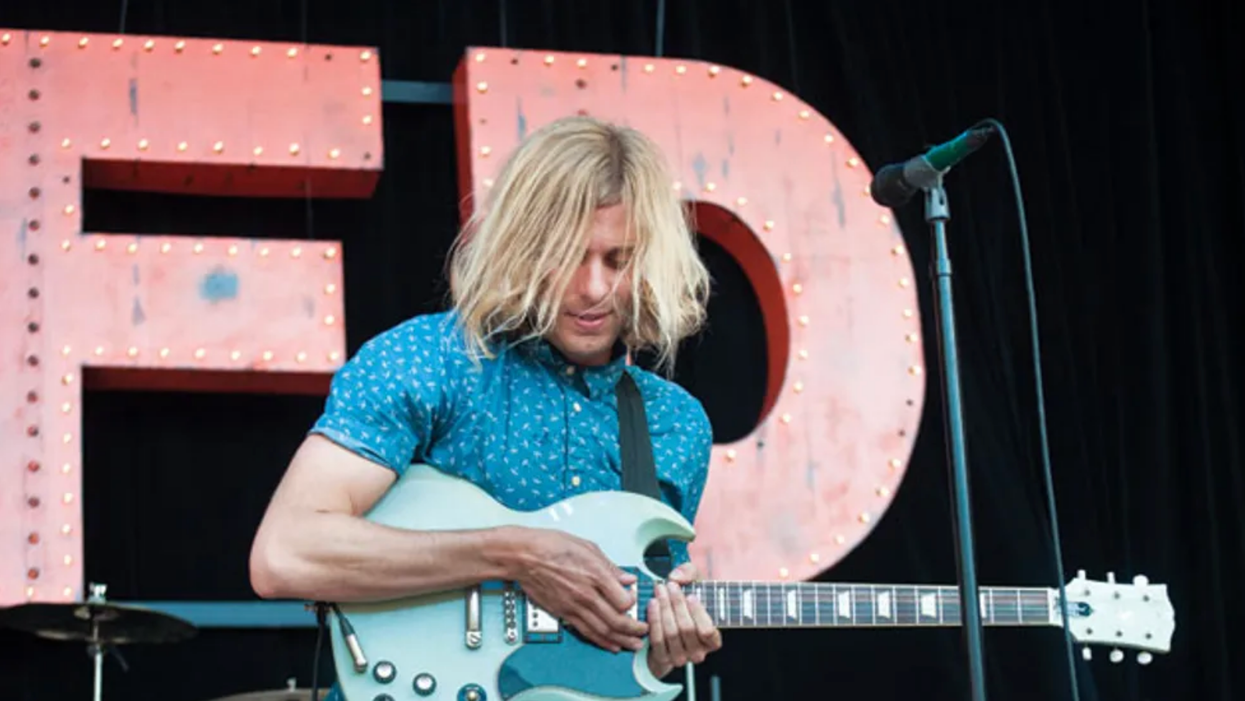

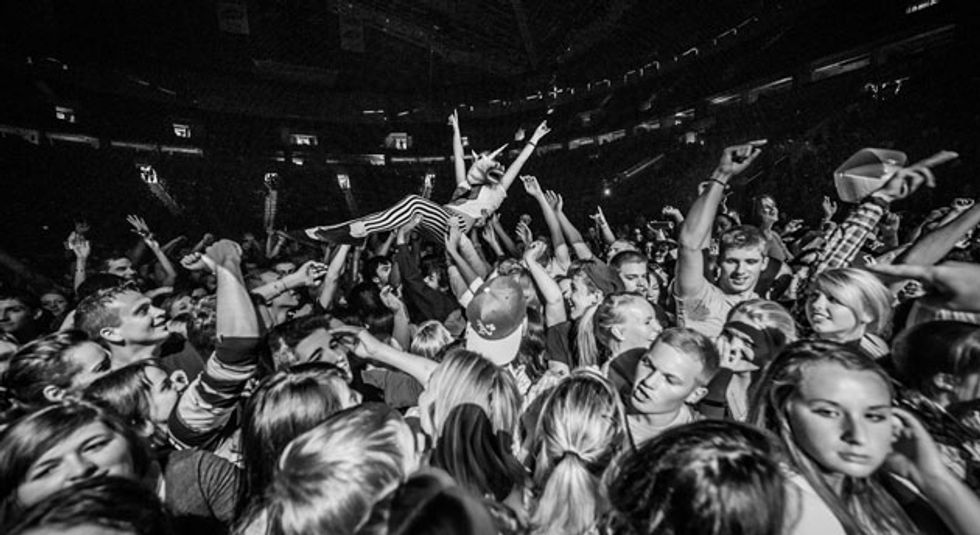
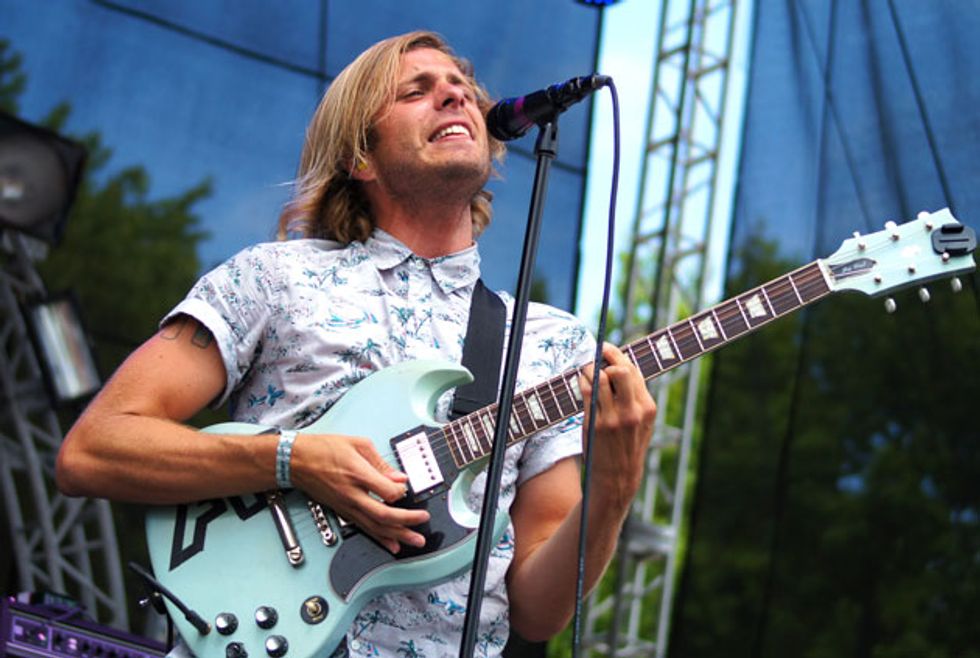






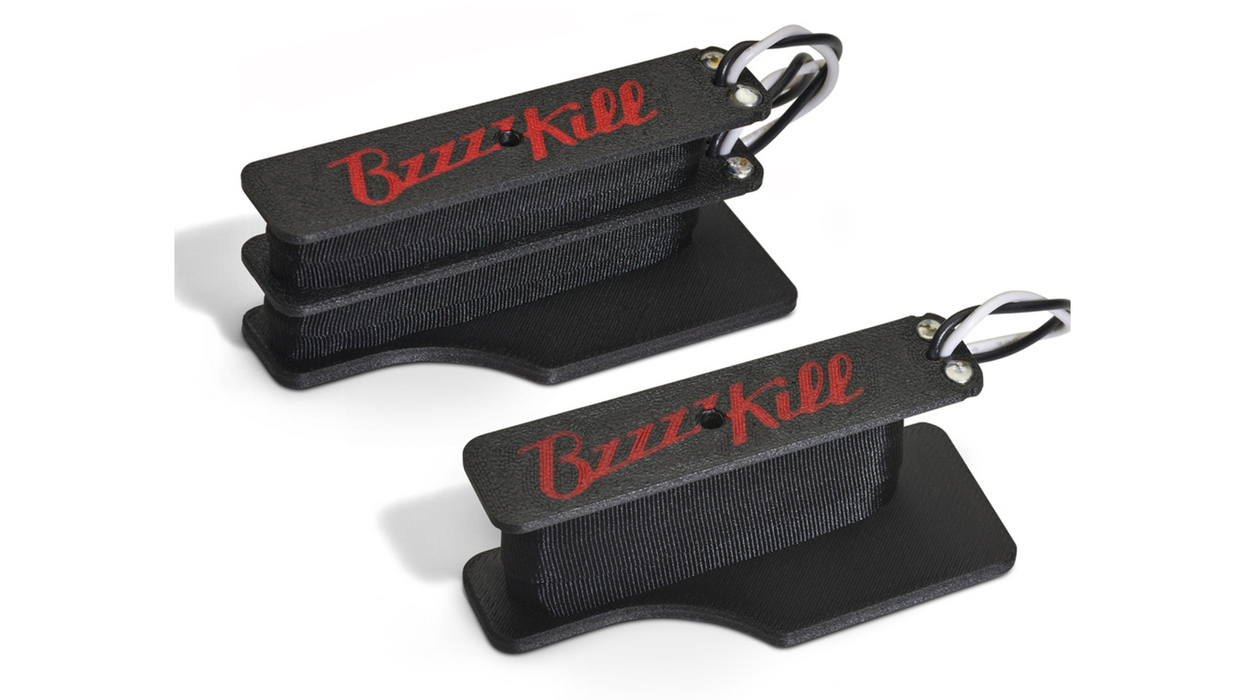



![Rig Rundown: Russian Circles’ Mike Sullivan [2025]](https://www.premierguitar.com/media-library/youtube.jpg?id=62303631&width=1245&height=700&quality=70&coordinates=0%2C0%2C0%2C0)










![Rig Rundown: AFI [2025]](https://www.premierguitar.com/media-library/youtube.jpg?id=62064741&width=1245&height=700&quality=70&coordinates=0%2C0%2C0%2C0)




















 Zach loves his Sovtek Mig 60 head, which he plays through a cab he built himself at a pipe-organ shop in Denver. Every glue joint is lined with thin leather for maximum air tightness, and it’s stocked with Celestion G12M Greenback speakers.
Zach loves his Sovtek Mig 60 head, which he plays through a cab he built himself at a pipe-organ shop in Denver. Every glue joint is lined with thin leather for maximum air tightness, and it’s stocked with Celestion G12M Greenback speakers.











